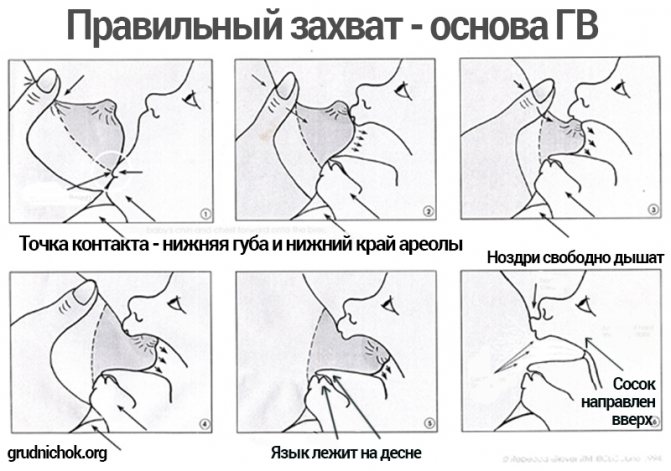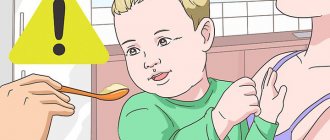I am writing this article to help those mothers whose children have given up breastfeeding. But to a greater extent - so that such problems do not arise for everyone else.
The child is hungry. He's looking for breasts. But as soon as the mother offers it, the baby turns away, arches, pushes away, and all this is accompanied by hysterical screams of the baby and mother... I myself have experienced this and I know how difficult a child’s refusal and attempts to return breastfeeding are for a mother.
Why does a child refuse the breast?
All possible reasons for refusal are divided into two large groups: psychological and physical. Psychological reasons lead to the so-called false refusal of breastfeeding. In this case, the child does not experience physical conditions that would interfere with the process of natural feeding. We are talking about internal anxiety, which is expressed in this form. If there are physical reasons, we are talking about true breast refusal, when the baby experiences physical difficulties when trying to get enough milk.
The child refuses for psychological reasons
Resentment, fear, psychological trauma
A newborn has a strong emotional contact with his mother, who is practically his whole world and source of life. Situations when this emotional contact is disrupted and the baby begins to feel detached, abandoned by the mother, and even worse, threatened or uncomfortable by her - this is a very real threat to the continuation of natural feeding. What can cause such stress in a baby?
Frequent absences and prolonged absence of a nursing mother
Naturally, the mother leaves the baby at such an early age for various reasons, sometimes very objective. A woman may get sick and end up in the hospital. Sometimes circumstances force a young mother to immediately go to work. No matter what good intentions this is done, for a child the absence of a mother is extremely stressful , because the baby spent most of his life in symbiosis and close connection with a woman. Separation and perception of the mother as a separate person occurs gradually, so for the baby, separation from her mother is tantamount to separation from part of her own body.
Insufficient body contact
It happens that a woman does not leave home for a long time, but does not give the baby enough of her close presence and affection. This often happens under pressure from “authoritative” friends and relatives: “Don’t carry it in your arms all the time - you’ll get used to it!”, “You’ll break your back!”, “They’ll ride on you!” A young mother will hear all sorts of recommendations. But it is worth considering that for a baby the need for frequent and close physical contact is not a whim or a whim. At first, bodily sensations are the main source of information about the world, and mother’s scent, heartbeat and warm hugs are the most beautiful and desirable. Children who are left alone for a long time, not held or caressed, may not only refuse to latch on to the breast, but also lag behind in development.
Unpleasant manipulations
This reason is the scourge of “advanced” parents who thoughtlessly strive for early comprehensive development and education of a “superman”. When a baby is subjected to unpleasant manipulations, he experiences discomfort and a desire to move away from the source of discomfort (the mother). After all, all these stressful situations occur with the permission (and more often with the active participation) of the beloved mother, who previously protected the child from all adversity. Hardening in cold water and similar procedures may not lead parents to the result they expect. If the baby is not ready to stay in extreme conditions and experiences active discomfort, it is quite possible that he will begin to refuse the breast.
Don't try this at home!
“Regular” approach to organizing feeding
A relic of the Soviet era is still alive in the memory of previous generations. Along with advice on tight swaddling, today's mothers are given the "valuable" experience of feeding "by the hour" - for example, offering the breast every three hours during the day with a six-hour break for sleep at night. This is probably convenient for the mother - in such a situation it is easier to manage her time. But what does the unfortunate baby experience, who, for some unknown reason, is being taught to a certain regime? The most compassionate ones allow you to offer water during the mandatory breaks, while others advise distracting. These are outdated ideas with traumatic consequences for the child’s psyche (and, sometimes, health). Adherents of such a system argue with nature and refuse to satisfy the basic needs of satisfying hunger and thirst of a helpless child. Remember that in the mother’s belly the baby received nutrients (= ate) 24 hours a day, so the transition to “intermittent” feeding through the mouth outside the mother’s belly is already stressful for him. There is no need to make it worse. According to current WHO recommendations, a child up to 6 months should be fed on demand.
Overexcitement from excess impressions
In the process of development, the child is rebuilt from internal to external perception. This is a natural process of psychological restructuring. A huge unknown world opens up before the baby, full of new impressions and evoking a variety of emotions. In the course of learning, a small person spends a lot of mental and physical strength. This is also stress, which leads to overexcitation of the nervous system during wakefulness. The baby is simply distracted by exploring the world, forgetting that he is hungry, and therefore refuses to take the breast. Please note that at night and around dreams the baby usually suckles without problems.
Solutions to other problems associated with breastfeeding can be found in our special project “Breastfeeding from A to Z”
What to do if a child refuses breastfeeding?
It is important to understand that problems with breastfeeding can also arise due to a temporary lactation crisis, when there is less milk than before, and the child freaks out precisely because of this. Not eating enough and not receiving enough of the usual portion of food, the baby sleeps poorly, is capricious, and behaves inappropriately at the breast.
What measures will help improve lactation and the feeding process:
- Put the baby to the breast frequently, the interval between feedings can be made very short - 1-1.5 hours. In this case, you need to offer both glands alternately.
- Stop feeding your baby formula and supplementing with water if he was previously completely breastfed.
- Increase the duration of application to stimulate the production of prolactin and oxytocin - hormones responsible for milk production.
- Massage the mammary glands and apply warm compresses.
- Avoid stress and physical fatigue - some of the housework can be delegated to your husband, mother and other close relatives.
- Balance your diet, consume more vitamins, proteins, drink at least two liters of liquid (preferably warm) a day.
Having dealt with the physical and psychological state of the young mother, you should pay attention to the baby’s mood. What to do if the baby cries and does not take the breast? Perhaps he was frightened by something, his mother began to pay less attention to him, the baby feels the loss of the previous emotional contact with his loved one. The following methods will help in this situation:
- the woman’s constant presence next to the baby, and not just during latching - the baby must restore trust and feel skin-to-skin contact;
- feeding in a calm environment, in a room where there are no loud sounds, the mother can relax and not worry, because emotional stress is transmitted to the child;
- feed on demand, even at night; by the way, co-sleeping saves you from the whims of the baby near the breast;
- Do not allow unfamiliar people with whom the baby may be afraid.
On a note! To increase the baby’s trust in his mother, it is important to shift unpleasant procedures to his assistants - let dad or grandmother do this, then the baby will have only positive associations with his mother. In order for the baby to start actively sucking the breast again, you can drop a little milk on his tongue to feel the familiar taste. At the same time, it is important to completely eliminate bottle feeding and supplementation.
What to do if a child refuses breastfeeding in late infancy?
If the child is already 8-9 months old, he is freaking out, is capricious and has stopped breastfeeding - what to do in such a situation? Often the problem is associated with the mother's prolonged absence. The baby has already grown up, many women go out to work part-time, or begin to leave home more often, leaving the child with their grandmothers. If the baby is capricious and does not latch on to the breast for the reason mentioned, it is important to try to pay more attention to him. When you come home, carry him in your arms, sing a lullaby, and give him a relaxing massage.
What to do if the baby refuses to latch on the breast, and the mother suspects that this is due to the baby’s poor health? First of all, find out what the problem is. There are several factors that can cause a baby to become capricious and stop eating normally:
- Teething – in late infancy, the baby’s front teeth have already appeared. And the lateral molars, which are just about to be cut, cause a more pronounced deterioration in health. It is difficult for a baby to latch on to the breast due to inflamed and itchy gums, which is why he cries and freaks out during feeding.
- Somatic diseases - colds, abdominal cramps, mild runny nose or severe nasal congestion. For example, rhinitis prevents the baby from breathing normally, which is why he continually drops the breast during latching and cries.
- Introduction of complementary feeding - many mothers, when starting to feed their baby meat or fish, become so zealous that they prepare too high-calorie and nutritious dishes. As a result, the baby eats up, does not feel hungry and, as a result, does not breastfeed due to satiety.

Advice! If a woman notices signs of pathology in her baby, or his teething is very painful, it would be a good idea to show him to the pediatrician. Most often, after recovery and the eruption of molars, the problem is solved on its own - the child is actively attached to the breast again, and whims and crying remain a thing of the past.
When should you not panic?
Cases when a woman begins to panic because her baby refuses to breastfeed are more often recorded among young and inexperienced mothers. Considering that the child must ask for food every 2 hours, they worry when the baby sleeps for a long time during the day, does not wake up at night and does not breastfeed. Here you need to understand that all children are different, and one requires feeding often, while the second needs a small portion of milk to sleep without interruption for several hours.
To make sure that the child is not hungry and is fully fed, it is better to keep a food diary - to record the last time the baby ate, whether he emptied one or both glands at once, and how he behaved during feeding. Some especially concerned mothers even weigh their baby before and after feeding to find out exactly how much nutrition he received at a time. If the results obtained correspond to age standards, it means that the baby does not breastfeed simply due to lack of hunger.
Causes of physical failure
In case of true breast refusal, you need to look for a material reason - a painful condition, a physical difficulty or obstacle.
Using pacifiers and pacifiers
All kinds of mother’s “helpers” that can calm a crying baby or facilitate the process of supplementary feeding or supplementing from a bottle are not always compatible with the process of breastfeeding. A pacifier, which is offered to a baby between feedings, satisfies the sucking reflex, but nature has not invented such “technical devices.” The child satisfied his needs during the feeding process. In addition, the shape of even the most physiological nipple or pacifier is not similar to the breast, and in the process of sucking the baby gets used to making efforts of a different nature, placing his lips and tongue differently. In the future, this can lead to breast refusal. In the case of bottles, there is another aggravating factor: less effort is needed to get milk through the nipple. If the baby understands this, then natural feeding will be in jeopardy. For more information about when you should use a pacifier and when it is best to avoid it, read the article The benefits and harms of pacifiers
Physical illness
Colic: When the tummy is bloated, the baby cannot concentrate on sucking, even if he is very hungry. Runny nose: During the first six months of life, a newborn is only able to breathe through the nose. In addition, a child's nasal passages are very narrow and tend to close very quickly if the mucous membrane swells or discharge appears. A runny nose interferes with breathing, particularly during feeding. Thrush in the mouth: the development of a fungal infection in the baby’s mouth causes discomfort during sucking. If the baby abandons the breast and is capricious, check if there are whitish areas with a cheesy coating on the mucous membranes. Otitis: If your little one's ears hurt, feeding hurts. The baby has short ear canals, and during sucking, a vacuum is formed in the oral cavity, which causes pain in the ears.
Incorrect attachment as a cause of failure
Inexperienced mothers often have no idea that their child is refusing to breastfeed because their feeding process is not organized correctly. If the baby only latches onto the nipple, there will be no milk. To activate the milk supply process, you need to squeeze the areola. In this case, the mouth should be wide open, and a vacuum should form in the oral cavity. Read more in the article about proper breastfeeding.
Milk flow too strong/weak
If the breast is full and the baby is below the level of the mammary gland, then during feeding the milk may flow excessively abundantly and actively. The baby will choke. In the opposite situation, when there is not enough milk in the breast, or the woman is tense, the baby makes incredible physical efforts to suck out the fluid. In both situations, the baby may begin to refuse, and both need correction.
LACTATION CRISIS. A lactation crisis is a certain stage of feeding, usually corresponding to a growth spurt in a baby, when the amount of milk in the mother has not yet adjusted to the new needs of the child. The first lactation crisis usually occurs in the third month of a child’s life. This is a separate case, and read about it in a separate article.
All of the above reasons for refusal can be eliminated with a competent approach. To restore natural feeding, it will take 1-2 weeks, and compliance with the recommendations appropriate to the situation.
What to do if the baby does not latch on to the breast?
From the first days
There are several reasons why a baby refuses to latch on at the first feeding. They can be divided into two main groups: reasons related to the condition of the child, and reasons related to the characteristics of the mammary gland or the behavior of the nursing mother.
Reasons related to the child's condition . This group of reasons includes the lack of adequate sucking due to the immaturity of the sucking reflex in the newborn or its inhibition due to hypoxia (oxygen deficiency).
In this case, the child needs the help of a pediatrician in combination with gradual but constant training breastfeeding. Correct feeding technique and a free feeding regimen help gradually, over several days, to form a sucking reflex. A child with an immature or suppressed sucking reflex cannot receive the required amount of milk at one feeding, so it must be applied to the breast more often and not held there for more than 15 minutes so that the baby does not get tired.
This group of reasons also includes a reluctance to breastfeed due to a lack of hunger at the time of feeding, if the child received supplementary feeding from a bottle before feeding. There is only one way out - wait until the baby gets hungry.
Difficulties with the first breastfeeding may also occur in those newborns who received food from a bottle during the first day, due to the fact that they develop a different sucking stereotype - the so-called “horn” sucking. In this case, an attempt to put a newborn to the breast causes negative emotions in him, up to a sharp cry.
If breast refusal occurs due to the formation of an incorrect sucking stereotype, the tactics should be the same, but in this case even more endurance is required from the mother. The child just needs to be taught to suck again, but at the breast, and in no case should he be offered anything else during this period. Gradually he will forget the bottle and adapt to his mother's nipple.
Reasons related to the behavior or physiological characteristics of the mother . Such reasons include, first of all, the structural features of the nipple (flat or inverted), as well as pronounced swelling of the nipple due to lactostasis - stagnation of milk precisely in the final excretory ducts - in the areola area. In these cases, the child has a healthy feeling of hunger and a pronounced sucking reflex, but breastfeeding is either severely difficult or impossible due to the fact that the baby cannot immediately adapt to his mother’s breast.
If a newborn refuses to latch on due to the structure of the nipple, there are two ways to help him. The first method is to use special overlays that imitate the correct shape of the nipple. And the second method is to gradually accustom the child to the shape of his mother’s nipple. If the nipple is swollen due to lactostasis, it is necessary to direct efforts to combat it, reduce the amount of fluid consumed and carefully express the breast before feeding in order to develop milk passages. After eliminating the swelling of the nipple, newborns willingly take the breast.
It often happens that during the first attachments there is a combination of maternal and infant factors that complicate feeding and cause breast refusal. For example, the mother may have flat or inverted nipples, and the newborn may have an immature sucking reflex. Or the baby is put to the breast after being fed from a bottle several times, while the mother develops lactostasis due to a pronounced flow of milk. In these cases, the first application becomes even more difficult. At the same time, the cry and irritation of a newborn often causes a feeling of despair and lack of confidence in the mother, which further aggravates the problem. Sometimes, after several unsuccessful attempts to breastfeed the baby, the mother gives up, and she begins to think about transferring the baby to artificial feeding. “He doesn’t take the breast!” - one has to hear a sad conclusion.
In these cases, try to adhere to the above recommendations and remember that if there is milk, then all other causes can be eliminated, although, of course, you need to make an effort and be patient.
Tips for mom
To make your child comfortable, try to distract yourself from all external factors and enjoy communicating with your baby. Always feed in the same room. Take the most comfortable position when feeding. You can play soft music and drink warm tea before feeding. All this helps you relax and tune in to a pleasant, leisurely feeding. And the mother’s condition is most directly transmitted to the child.
Giving up the usual
And it also happens: a child who has been suckling perfectly at the breast, suddenly, when trying to attach him to the breast, suddenly begins to scream loudly and turn his head to the side. At the same time, he behaves in such a way that it is clear that he is hungry. But neither this nor subsequent feedings cause him the same joy: the baby completely refuses the breast or sucks very little and reluctantly. At the same time, feeding from a bottle with expressed milk is perceived well by the child - he sucks his portion and in no way shows dissatisfaction, which is so pronounced when breastfeeding. This situation cannot but upset the mother. She begins to worry, fearing that her baby will never want to breastfeed again.
Why is this happening? What causes this behavior? What can trigger temporary breast refusal? It is temporary, because with correct behavior on the part of the mother, after a while the child readily begins to suckle at the breast again. And only if the mother does not have the necessary information and support, the problem of the child’s temporary refusal to breastfeed can develop into the need to transfer him to feeding with expressed milk, and subsequently to artificial feeding.
Refusal to breastfeed a child who has been breastfed for more or less a long time can be caused by various factors, the root cause of which is almost always the same - the baby’s stress. It can be caused by a cold or viral infection, psychological discomfort in the family, a sudden change in the environment, a change in the taste of breast milk or a marked decrease in its quantity. Let's consider each of these reasons in relation to its impact on feeding.
In case of a cold, the baby refuses to breastfeed due to the fact that infections, accompanied by an increase in body temperature and general malaise, cause a decrease in appetite and a reluctance to breastfeed. And since breastfeeding requires certain physical effort from the baby, if the baby’s health worsens, discomfort may prevail over the feeling of hunger. The child, of course, wants to eat, but he doesn’t want to put any effort into it during this period of time; the baby doesn’t have the strength to eat!
This is especially aggravated in cases where a cold or viral infection occurs with a severe runny nose. Difficulty in nasal breathing can be a serious obstacle to breastfeeding. Obviously, at a time when the baby cannot breathe normally through the nose, the act of sucking (and especially sucking the breast) becomes so difficult for him that, instead of satisfying hunger, the baby begins to scream loudly, thus ensuring access of oxygen to easy.
If the baby cannot breastfeed due to a severe runny nose, it is necessary to use nasal drops, the effect of which is aimed at eliminating swelling of the nasal mucosa. Sometimes, during a child’s illness, it is necessary to temporarily transfer him to feeding with expressed milk. During this period, the most important thing is that the child restores the strength spent on fighting the disease, making less effort. To do this, it is best to feed the baby from a spoon. Usually, after feeling better, babies begin to breastfeed again with the same pleasure.
At an older age, teething may be the reason for breast refusal. During this period, it is necessary to help him and alleviate his discomfort. Special pastes and gels that are applied to the gums and cause relief from pain and itching will provide good help.
Mother's milk
may change her taste in cases where she eats foods with a pronounced odor, for example, fresh onions and garlic, most spices, and marinades. It is unlikely that a child will like such an innovation as mother’s milk flavored with garlic or bay leaf. He starts to suckle, but then drops the breast and starts crying.
Watch your diet and do not include foods with a strong taste and smell in your diet: onions and garlic that have not been heat-treated, spices.
A sharp decrease in the amount of milk, which is observed during lactation crises (usually once every one and a half months), can also cause breast refusal. In this case, the baby regards the half-empty breast as deception, bitter disappointment and begins to be loudly indignant instead of making more efforts to satisfy his hunger.
If your baby stops breastfeeding out of irritation due to insufficient milk supply, focus your efforts on getting more milk. In this case, more frequent breastfeeding than before can play an emergency role. In addition, at one feeding it is necessary to attach the baby to both glands. The baby will not be so upset if, a few minutes after the start of feeding, he receives the second breast. In addition, this feeding regimen helps restore lactation faster. During these periods, the mother especially needs to eat well, drink 2-3 liters of fluid per day, and get more rest.
Psychological discomfort in the family can be one of the reasons why a baby refuses to breastfeed. Moreover, this reason is the most delicate and difficult to eliminate. In cases where parents speak in a raised voice in the presence of a child, when the mother is upset, upset or very worried, the baby is also in confusion, he feels that something is changing in the world around him, and this can cause him such stress that he refuses to latch on. The little one is trying to draw his parents' attention to the fact that he is scared and upset in a way that is accessible to him.
If during breastfeeding the mother is distracted, for example, talking on the phone, loudly discussing something with her family, if she feeds the baby in an uncomfortable position, the baby may also refuse to breastfeed. But in this case, the refusal will not be systematic - once the cause of the refusal is eliminated, the baby will happily resume sucking.
One of the reasons for breastfeeding can be a sudden change in the situation - moving to a new place of residence, traveling with a child, even feeding him in another room. This applies mainly to babies with a peculiar mentality - the so-called especially impressionable children. In most cases, a sudden change in the environment is some stress for babies, but still not so pronounced that they begin to refuse breastfeeding. On the contrary, it is often in the process of sucking the breast that children get rid of the tension associated with changing places.
Elimination of psychological causes depends only on adults. This should be the result of the conscious work of all family members aimed at improving the psychological atmosphere in the house. Talk to all family members and ask them to never speak in a loud voice while feeding the baby, even if the argument is in another room.
If your baby refuses to latch on for any reason, try sprinkling breast milk on his tongue. Often, having felt the taste of milk on the tongue, the child readily begins to suck. If this does not help, but at the same time there is confidence that the child is healthy, that all external causes that could cause breast refusal have been eliminated, you can wait a little with feeding. It may well be that after a couple of hours he will become more hungry and the problem of breastfeeding will be solved.
In any case, maternal love and patience, her faith in her own strength and desire to continue breastfeeding can help the child return to the previous feeding regimen.
Elimination of psychological causes
We feed on demand
If your baby is stressed by the “regime” style of feeding, it is important to restore trust and understanding that the breast is available at any time.
- Offer the breast to your newborn half hour to hour.
- For a baby up to 4 months , this period is 1-1.5 hours. In general, if your baby hasn't slept for 2 hours, encourage him to snuggle hourly.
- Children over 4 months should be applied every 2 hours
Feeding with “white noise”
“White noise” is a monotonous background sound of varying intensity and frequency. Similar sounds are produced by a radio on an empty frequency, a waterfall or water flowing from a tap, a running hair dryer, a vacuum cleaner or a fan. In “white noise” conditions, babies stop getting irritated and worried, often calm down and fall asleep. Why is this happening? The memory of intrauterine life is triggered, when the child was constantly surrounded by physiological sounds of the body caused by the work of the stomach and intestines, heartbeat and blood flow in the great vessels. Over nine months, the baby gets used to these background (and quite loud) sounds, and “white noise” has a calming effect. Try feeding your baby to the sound of running water (or turn on a white noise recording) and you will see that he no longer refuses to breastfeed.
White noise for babies
Ocean sounds for baby's sleep
Feeding in the dark
Dimmed or absent lighting has a calming effect on the newborn , because the stomach was also not very light. The lack of light combined with rocking can put the baby into a half-asleep state, when it will be easier to offer the breast and achieve sucking.
Restoring trust
If the child begins to refuse breastfeeding due to resentment towards the mother, then it is worth providing the baby with enough attention from the mother:
- Try to spend all your time in close physical contact with your child.
- Establish co-sleeping (use extreme caution)
- Give up the stroller for a while and carry your baby in a sling
- Practice skin-to-skin contact - place the undressed child on top of you during sleep, bathing, and communication.
- Choose moments of maximum calm for feeding, when the baby has just woken up or is starting to go to sleep.
Nesting method
This is the most effective, but also the most difficult method , which is recommended for restoring breastfeeding after psychological trauma. What should be done? First of all, ensure constant close physical and emotional contact with your mother. During the nesting period, the presence of any other people must be excluded from the baby’s life. For several days, the mother stays in a quiet, darkened room with the child. Most of the time is spent in bed next to the baby. The mother lying nearby constantly offers the baby her breast, without being distracted by any other concerns. Even if the baby is sleeping or not hungry, try not to be away for more than a few minutes. Such close spending time will allow the baby to constantly feel the presence of the mother and restore trust. Agree that during this period your loved ones take care of all household chores.
Nutrition tips for a nursing mother
The daily menu of a nursing woman is not much different from the usual, familiar before the birth of the baby. The only caveat is that dishes should now contain 500-600 more calories to ensure full milk production. It is important to monitor the condition of the baby and note his allergic reactions to certain foods eaten by the mother. If a skin rash appears, the baby's tummy is bloated, and the baby's temperature rises, some foods will have to be excluded from the diet.
It is useful to eat fermented milk, boiled and stewed vegetables, lean meat, and lean fish. You should completely exclude soda, fast food, strong tea and coffee, over-salted and overly spicy dishes. Mothers with allergies should avoid citrus fruits, strawberries, nuts, chocolate, seafood, and chicken eggs in large quantities. Following a diet will allow you to continue breastfeeding without fear and will not provoke a situation where the baby refuses to breastfeed due to health problems.
A balanced diet, the right psychological attitude and giving the child enough attention are the key to ensuring that the baby will actively suckle at the breast. If the baby has stopped feeding the iron, cries, is capricious and sleeps poorly, you should not let things take their course. First of all, you need to make sure that he has no health problems, and then promptly resolve issues with the young mother’s nutrition and possible psychological problems.
Eliminating physical causes of failure
We treat ailments
If you suspect that breast refusal is caused by a painful physiological condition (there are other symptoms), contact your pediatrician . It is important to establish a diagnosis and carry out therapy as soon as possible.
We refuse any breast substitutes
The first thing to do if your baby stops latching is to remove any pacifiers and nipples . With a pacifier the situation is simpler: the sucking reflex is satisfied during feeding. If your baby needs to be fed or supplemented with water, do not use a bottle. Use a spoon or a plastic syringe (without a needle), try using a sippy cup.
We apply it correctly
When attaching your baby, make sure that:
- the head is not thrown back or turned to the sides, the chin is not pressed to the chest;
- the mouth is wide open so that in the grasping position the lips are turned outward, and dimples form on the cheeks during sucking;
- baby grabbed the areola, not the nipple
- To start feeding, bring the nipple to the corner of your mouth. The baby will reflexively open his mouth and turn towards the chest

Changing the feeding position when there is abundant milk production
If the baby is choking while trying to latch onto a breast that is full of milk, change the position so that the breast is lower than the baby's head during feeding. Try placing your baby on top of your chest while lying on the bed. Make sure that the baby's nose is not covered by the mammary gland. Also, express some of the milk before feeding.

Stimulating milk production during weak lactation
If your baby refuses to breastfeed because he has to exert too much force to suck the milk, try to relax as much as possible before feeding. Take a warm shower, thinking about the upcoming communication with your baby. Massage your breasts in the direction of the milk flow. Try massaging your breasts a little before feeding to stimulate more active milk production and flow. You can also feed in an overhang position so that gravity helps your baby suckle.

Is supplementation necessary when weaning?
The decision on the need for additional feeding should be made together with the pediatrician who has been monitoring the child since birth. Focus on weight gain or loss. Additionally, you can do a diaper test at home.
Diaper test
A simple method to determine whether your baby is getting enough nutrition. During the day, do not put disposable diapers on your child; use only cotton diapers or onesies. If after 24 hours there are at least 12 wet items, then there is no cause for concern - the child receives enough food and drink.
If the result does not live up to expectations, the child will have to be supplemented with formula. However, do not stop breastfeeding under any circumstances. Supplement your baby with a spoon or syringe. You can also use a pipette or purchase a special SNS system.










